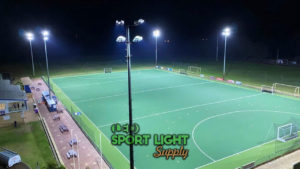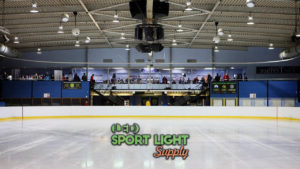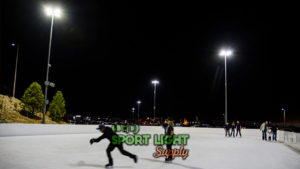What lights are used in hockey rink and ice arena?
1. Flood lights
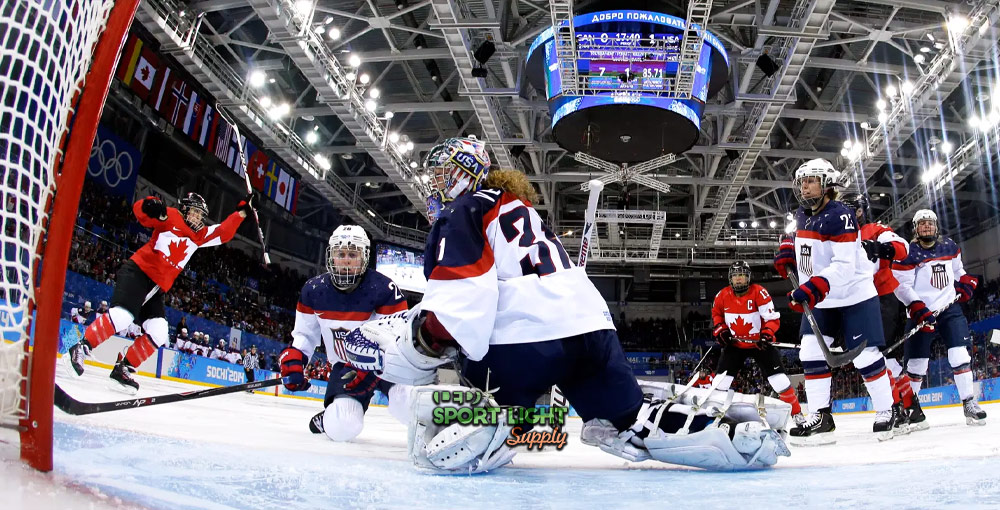
Ice hockey is a team sport and scoring goals lead to victory. Of course, before the goaltender can even try to block a shot with a spectacular save, many penalties occur. So, the lighting design must take care of several factors to ensure clear vision. For example, the overall layout of the ice arena and the distance between the light poles and the ice rink.
A flood light is a light fixture used for close range. Usually, you find it in an outdoor rink design. Mainly because it can provide enough brightness on a large area from a relatively close position. When the referee drops the puck between the two opposing centers, the latter ones scrap to win a position on the ice arena.
As the hockey rink has five main areas where most of the action happens, flood lights are useful to highlight every little detail. Besides, they are versatile and can be easily adjusted to allow players to skate faster and safely.
2. Spot lights
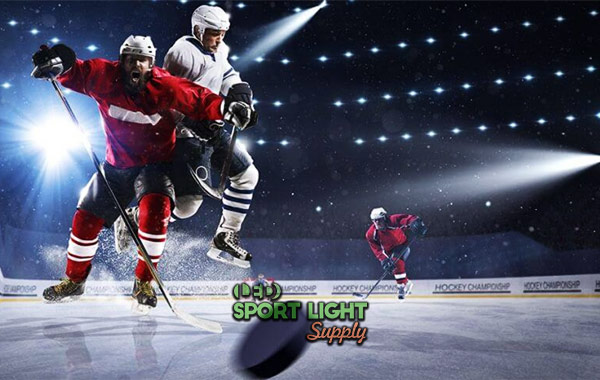 A spot light is the typical light fixture for long range. Which means you find spot lights in many indoor and outdoor sports and skating arenas.
A spot light is the typical light fixture for long range. Which means you find spot lights in many indoor and outdoor sports and skating arenas.
Thanks to a narrow beam of light, spot lights can illuminate a large area without causing glare. Of course, you need to install them at the appropriate height and distance. But their use greatly impacts the players’ stance on the ice and allows them to stride forward with ease.
Such light diffusion is ideal for letting defenders see what is going on. At the same time, the left and right wing forwards can speed their way through the neutral zone.
Inadequate lighting levels can cause dangerous body contact and injuries. So, using several spot lights is recommendable as they can prevent loss of illuminance.
In any fast-moving high-intensity sport, safety must be a top priority. Spot lights help lower the risk of injury by being extremely portable and easy to install.
3. Pole lights or high mast lights
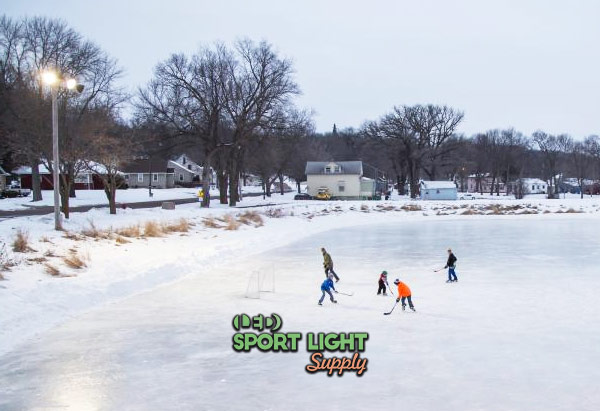 In an outdoor rink, the pole lights are close to the hockey rink. The goal lights are next to the goal judge’s position on each side. Usually, four poles stand near the points where the blue lines meet the ice rink. Lastly, two lights poles illuminate the center.
In an outdoor rink, the pole lights are close to the hockey rink. The goal lights are next to the goal judge’s position on each side. Usually, four poles stand near the points where the blue lines meet the ice rink. Lastly, two lights poles illuminate the center.
High mast lighting is an efficient way to mount energy-saving LED flood lights and spot lights. Remember, you need more powerful lighting devices with higher luminous efficacy as the distance between the outdoor rink and the high mast increases.
LED products have a superior life span. With modern module design, achieving the recommended light level should not be a problem. But periodic high mast maintenance is required to eliminate corrosion or other potential issues.
4. String lights
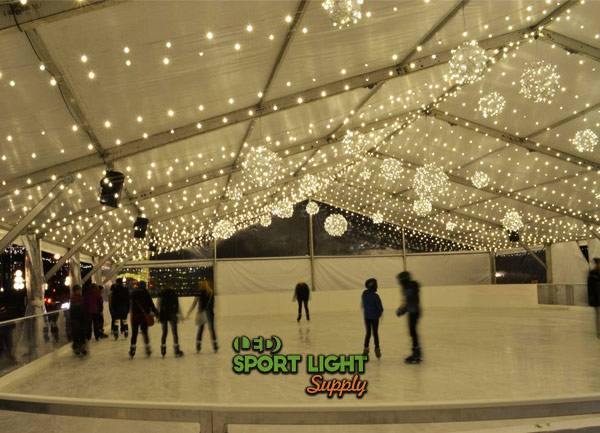 If you have a backyard hockey rink, string lights are a pleasant, useful decoration. These lights are the ideal solution for an ice arena without light poles around it. In fact, you can tie the string lights right to some trees and create a custom lighting design.
If you have a backyard hockey rink, string lights are a pleasant, useful decoration. These lights are the ideal solution for an ice arena without light poles around it. In fact, you can tie the string lights right to some trees and create a custom lighting design.
The wattage and shape of these products vary. But they are usually LED products that offer a variable number of bulbs. Think of them as a more powerful version of Christmas tree lights. Of course, the twinkling effect may not be included in the price.
String lights are great to manage costs. For one thing, you can set up a layout line to measure the overall distance. For another, you can install a dusk to dawn sensor to let the lights automatically turn on and off.
5. UFO high bay lights
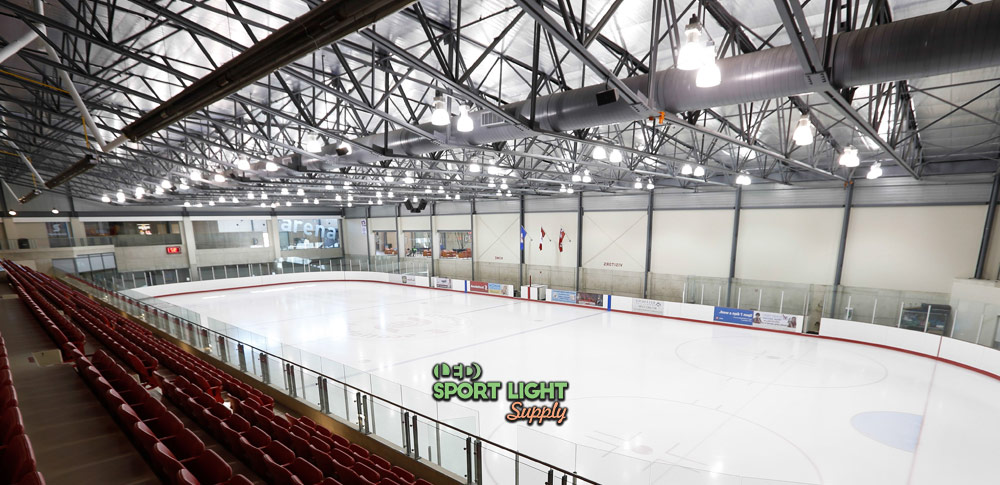
Depending on the indoor ice rink dimension, many 100-150 Watts units are necessary. In fact, these lights are evenly distributed on the ice arena ceiling to improve lighting uniformity.
In most NHL (National Hockey League) stadiums, the combination of UFO lights and spot lights ensures optimal illuminance. The standard high bay light is easy to install. Mainly because it comes out of the box in three separate pieces. That is, the lamp, the cords (main power lead and a dimmable option, if applicable), and the hanger or ceiling-mount bracket.
As you can hang them right over the hockey ring, each fixture improves the players’ vision. At the same time, the lighting bodies help the referee make sure that the attacking player hits the puck over the goal line. Or to assess whether the puck crossed the line to score a goal.
Hockey Rink Lighting Design
1. Lux (brightness) requirement
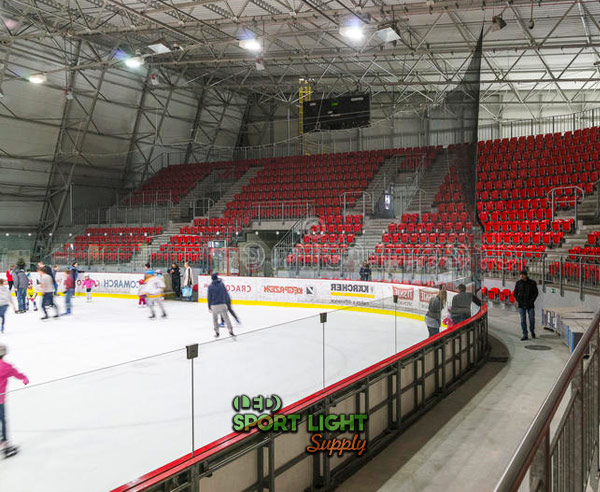 An ice hall may host several events. So, usually, the fixture layout is optimized in accordance with the level of competition. In other words, the lighting design must comply with several lighting requirements.
An ice hall may host several events. So, usually, the fixture layout is optimized in accordance with the level of competition. In other words, the lighting design must comply with several lighting requirements.
As you may know, each light fixture has a lumen output. That is, a numeric value that expresses the total light output of the source. The higher the lumen value, the brighter the light. But of course, the further the distance of a light source from the hockey rink, the greater the light loss.
Lux is a unit of measure that refers to the light falling on a precise area. In detail, it combines the lumen output and relates it to the area that needs light sources. With a lux value, you can adjust the lighting no matter what the dimensions of the ice arena are.
Usually, four lighting classes apply to the ice arena:
- 1,200 lux for a large arena and competitions at the championship league level
- 800 lux for a small ice rink and competitions at the junior championship level
- 500 lux for local tournaments and junior leagues
- 250 lux for practice and training sessions
2. Lighting uniformity
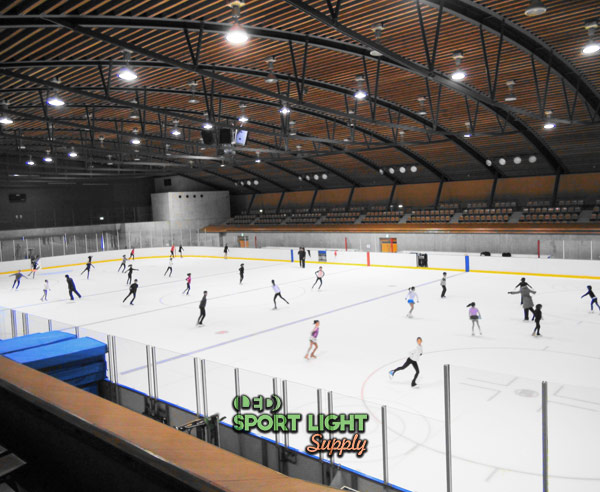 If the lux level helps us achieve the desired luminous intensity, lighting uniformity is about correct distribution. Of course, light distribution is critical for the players’ safety and concentration. For example, players can score a goal with any part of their stick, but they move at high speed. As the attacking player approach the attacking zone, concentration is key. Especially during an odd man rush. But if the light suddenly changes, that distraction can make the player lose or hit the puck inadvertently.
If the lux level helps us achieve the desired luminous intensity, lighting uniformity is about correct distribution. Of course, light distribution is critical for the players’ safety and concentration. For example, players can score a goal with any part of their stick, but they move at high speed. As the attacking player approach the attacking zone, concentration is key. Especially during an odd man rush. But if the light suddenly changes, that distraction can make the player lose or hit the puck inadvertently.
Lighting uniformity is the way we prevent any visual performance issues. In detail, it is such a critical factor that you can calculate two types of lighting uniformity (overall and longitudinal) in two distinct dimensions (horizontal and vertical).
Optimal lighting uniformity values change as the level of competition changes. As a rule of thumb, the horizontal overall uniformity should range between 0,70 and 0,80. Instead, the vertical overall uniformity should be between 0,40 and 070.
3. Color temperature
Kelvin (K) is the unit of measure of the color temperature. By definition, the color temperature refers to the fixture’s glow color. In short, some light sources have a bluish light, while others emit a yellowish tone.
The higher the Kelvin value, the bluish the light is. On the other end of the spectrum, you find yellowish hues. In the middle, you find the 5000-5500 K range, which mostly resembles daylight.
Choosing the right color temperature is essential for two main reasons:
- Televised events need slightly higher color temperature values. Usually, between 4,000 and 6,500 K for producing neutral-looking images.
- In every indoor ice arena, a specific color temperature is necessary to achieve a neutral white tone. Otherwise, the white uniform can look orange or gray-blue.
4. Color rendering index (Ra)
Artificial light may not render the color of the illuminated objects like sunlight would. So, the CRI (Color rendering index) value gives us a way to assess the ability of the light source in reproducing the daylight rendering.
By installing lighting devices with similar color rendering characteristics, visual comfort improves. Of course, the ice’s reflection factor should be considered too. Mainly because visual comfort allows the players to attack and defend more efficiently.
In virtually all ice arenas, the light sources should exceed a >90 Ra value. But a value between 70 and 90 Ra is also acceptable. This distinction is important due to the fixture surface depreciation. That is, the inevitable deterioration of the fixture properties as the lamp ages.
5. Glare-free
In hockey, players make contact with other players and the boards routinely. So, all efforts must guarantee that glare is not an issue during the match. Especially if the paint on the walls is white. Otherwise, the light can bounce off every white surface and blind the players.
Due to the reflective properties of the ice rink, a glare rating of 45 is the maximum permissible value. Then again, broadcasters would not be able to record and stream any match as well.
While there are ways to reduce glare, several accessories like glare shields are available. The lighting design must avoid any layout that uses big tilting angles. Instead, it should focus on better fixture positioning and improving light distribution.
Glare can cause a player to involuntarily make an opponent trip. But the referee will send off the player for a couple of minutes anyway.
6. Beam angle
In most situations, a larger beam angle (90 to 120 degrees) is better. For one thing, a large beam angle can help to illuminate a small ice arena.
If the ice hall has a low ceiling, the light can spread evenly before it reaches the ground. But smaller beam angle (30 to 60 degrees) can be the best option too. For example, in the case of a hockey ring under a high ceiling. The light beam will diverge less than a wide one would.
Different beam spreads can give you a lot of flexibility. So, it is important to have both. Starting with a 90-degree angle beam, the light will spread much more as the distance increases. Instead, a narrow, focused beam allows you to add light in precise spots to raise illuminance. Or to improve uniformity.
Outdoor ice hockey rink lighting layout
1. 4-pole layout
This is the simplest lighting layout you can find. In a 4-pole layout, the main aim is to provide enough brightness for each goaltender to see the central zones clearly.
The outdoor light pole height varies from 3m to 20m, depending on the level of competition. Of course, the use of this layout is more common for illuminating local competitions and training sessions. Thus, it is not unusual to see a short pole height. The shorter the pole height, the longer the shadows.
The main downside of this lighting design is the lack of enough light points to illuminate each area. Most likely, the area around the rink walls will not receive enough brightness. To overcome this problem, you could install the lights behind the four ice rink corners. But at the same time, you will increase the chances of causing glare.
2. 6-pole layout
The 6-pole layout is a popular choice. Mainly because it delivers enough brightness for small competition and figure skating events. Usually, the design involves six high masts around the ice arena. Powerful luminaries are on top of the 20-meter light poles.
The goal of this layout is to create a cost-effective lighting setup. So, the poles do not need to be perfectly aligned around the ice rink. Plus, each high mast may hold more than one fixture tilted differently for long- and short-range.
When using portable light towers, this layout ensures good vision. So, it is not unusual to spot this design in high mountain areas. Plus, arranging the light towers can prevent glare and reduce shadows even further.
3. 8-pole layout
This layout is the most professional and appropriate for hockey events out in the open. In most cases, two 8-poles layout types can be found. In the first one, 8 light poles are around the hockey rink at specific locations. That is, 4 near the blue lines, and 2 goal lights behind the goaltender on each side. In the second variation, 4 poles are on one side, and 4 on the other.
The second variation offers less uniformity. But it is an efficient lighting solution to illuminate the ice arena and eliminate most shadows. The only downside is the usual lack of space for the penalty box and the players’ bench. Often, this layout is preferred everywhere a compact solution is necessary. On the positive side, the vertical illuminance is better than in the first variation.
Indoor ice rink lighting layout
1. Distance between the high bay lights on the ice rink ceiling
Hanging a high bay light and installing it on a ceiling mount can change the lux readings on the artificial ice. Especially when the cord is very long.
The chief benefit of choosing to hang the UFO high bay lights is reducing the running expenses. For example, by adjusting the cord length to maintain lighting quality. Plus, installing the hanger is easy and allows for retrofit solutions in old facilities.
Most fixture models have stamped metal fins and the back housing is optimized for dissipating heat. In fact, the ceiling-mount bracket itself leaves space for the heat sink to function properly. Hanging the UFO high bay lights is recommendable in hockey halls where the air exchange is low.
2. Ceiling height
The ceiling height impacts several factors. For the most part, the direction and light efficiency (lm/W) of each fixture can influence the positioning. Also, the lumen maintenance factor comes into play when determining the lux levels.
In the modern indoor hockey rink, LED lights allow for cost-competitive layouts. Of course, a reputable designer would search for lighting devices with a low failure rate, but if the price is a problem, the fixture position can change.
By using a lux meter, achieving the lux standard should not be a problem. But the reflection caused by the distance between the light sources and the ice must not impair the players’ vision.
3. Number of luminaries
Upgrading the lighting system with high bay lights means choosing between 50 to 200 pcs of LED lights. Of course, the designer can group the lights for creating specific switches. Advanced lighting control systems can also provide an efficient way to turn them on and off at will.
More luminaries mean higher uniformity and better quality of play. In fact, when the attacking players lift the puck off the ice on the goal line, they are totally focused. They need to hit the puck with the stick blade with precision. At the same time, the goaltender must follow the action to prepare. Similarly, more luminaries will excite the audience during a penalty shot.
4. Shape of ice rink ceiling
Most NHL stadiums have a vaulted ceiling. Since the ice rink size is standard for every location, the buildings differ to allure audiences in varying ways. Of course, the ceiling being anything else but flat influences the lighting design. But at the same time, it can allow for more light patterns. Which means better visual effects during intermission or figure skating events.
One of the benefits of vaulted ceilings can include extra frames for tilted lights. As a result, the ads on the boards may receive more exposure, pleasing the sponsors. On the negative side, the designer could be forced to cram many fixtures right next to each other.
Instead, the lighting design on the flat ceiling is all about simplicity. In most hockey stadiums, shining from a corner, spot lights enhance the fan experience by lighting up the center ice.
5. Direct or indirect lighting
An architect can design a sports venue with the clear intent of using direct or indirect lighting to light up the hockey arena.
Indirect lighting occurs when the lights are pointing upward. In detail, the reflected light illuminates the rink by bouncing off the walls and ceiling. As a result, the lighting uniformity is higher and glare is held to a minimum. On the negative side, energy consumption is higher. After all, more powerful light sources are necessary.
Direct lighting is the traditional way to use fixtures by hanging and tilting them toward the ice rink. On balance, it is more affordable. But it can also pose a safety risk. So, most stadium owners need to buy protective grilles and other accessories.
Why is LED the best lighting for ice hockey rinks?
1. Reduce electricity bill
Most LED products have a luminous efficiency of 150lm/W, which is 2 to 4 times higher than metal halide, HPS, and HID lamps. Upgrading to LED reduces operation costs and is a more eco-friendly solution.
2. Long life span
The average LED flood light lasts thousands of hours. At least, 50,000 hours for most brands. Plus, LED tech reduces maintenance costs. In fact, the chips are binned. This means that each group of LED chips provides different color temperatures independently. So, if a color temperature becomes unavailable, switching to another range can extend its use until you install a new replacement.
3. Anti-glare
Some manufacturers use a special product design and term their LED lights as anti-glare products. In the ice rink, this means less glare and reflection on the ice surface. Ice skaters can be more comfortable and injuries avoided.
To achieve anti-glare, the light source may be recessed further back inside the casing. Or special coatings and lenses may increase diffusion slightly.
4. Keep an ice rink from melting
Unlike traditional light sources, LED lights do not produce heat. Plus, each LED device has a heat sink which allows efficient heat dissipation.
The low heat generation of LED lights preserves both the ice rink and the coating on the ceiling. While circulating the air in the hockey hall is always a good idea, heat has little chance to harm LED products. In comparison, overheating reduces the life span of old HPS and MH lamps consistently.
5. Wide range of color temperature options
The latest LED products come with interesting features. One of these let you choose the different color temperatures. Which is ideal for a recreational or professional ice rink.
How much does ice hockey rink lighting cost?
Depending on the field size, light pole height, level of competition, and so on, the price can vary. However, you can expect to pay anywhere between $8,000 and $150,000. Of course, the more reputable the provider, the better the results!


